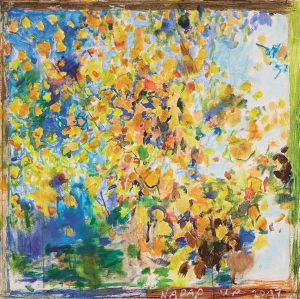
Péter UJHÁZI
18 Little Pictures
- Year(s)
- 2004-2005
- Technique
- acrylic on fibreboard
- Size
- 68x98 cm
Artist's introduction
The Munkácsy Prize-winning artist Péter Ujházi graduated in 1966 from the Hungarian College of Fine Arts' Painting Department. There seems to be virtually no trace of his masters, János Kmetty and Aurél Bernáth, in his work, which was the case for many of his contemporaries, who wanted to create "New Art". Ujházi developed his pictorial universe during the 1970s: his artistic position could be characterised with an anti-aesthetic attitude and a new aesthetic, which opposed high art. Ujházi has retained a fundamentally narrative approach to this day (reinforced by textual segments appearing in the works) and has developed this through various technical means: paintings, box pieces, collages, graphic work, assemblages, artist books and a series of wooden, ceramic and iron sculptures. One of his innovations is the unique "carousel perspective", which is established by the simultaneous utilisation of several perspectives. His other characteristic innovation is the figurative attitude reminiscent of children's drawings and graffiti. He has painted three major historical compositions in this style (The Siege of Fehérvár and the Deportation of Wathay, 1972; The Last Pagan Rebellion, 1972–73 and Jellasics's Run, 1973). From the four edges of a painting, a straight path led to scenes staged in a cosmic dimension and the conservation of everyday life's distinct locations and figures in the form of panoramas composed on the surface of the canvas. Expressive colours and a vibrant, gestural brushwork characterises his series depicting landscapes and foliage, which forms a significant chapter in the artist’s oeuvre since the late 1960s. Krisztina Kocsis – Katalin Keserü
More artworks in the artist's collection »
















